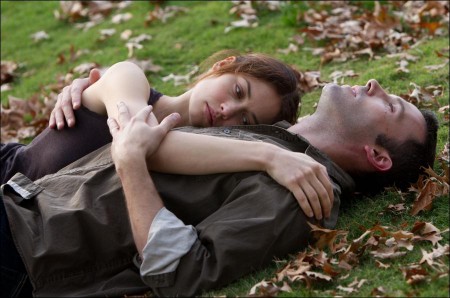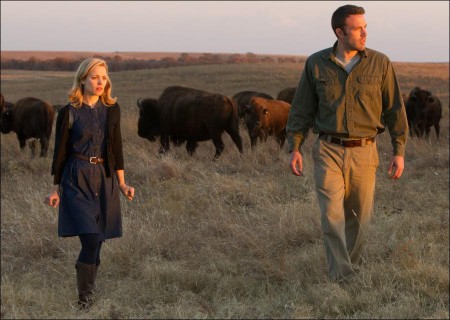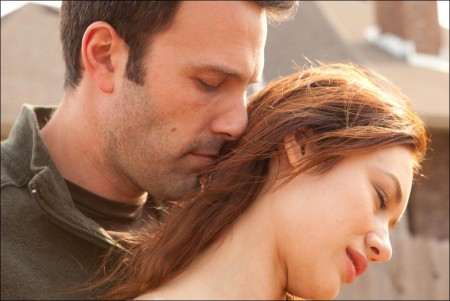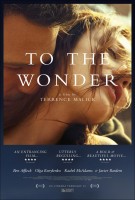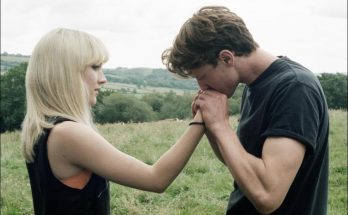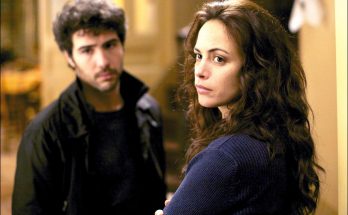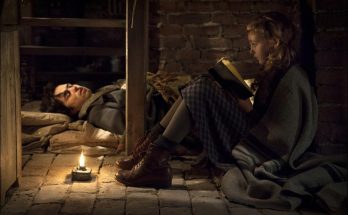Neil (Ben Affleck) is an American traveling in Europe who meets and falls in love with Marina (Olga Kurylenko), an Ukrainian divorcee who is raising her 10-year-old daughter Tatiana in Paris. The lovers travel to Mont St. Michel, the island abbey off the coast of Normandy, basking in the wonder of their newfound romance. Neil makes a commitment to Marina, inviting her to relocate to his native Oklahoma with Tatiana. He takes a job as an environmental inspector and Marina settles into her new life in America with passion and vigor. After a holding pattern, their relationship cools.
Marina finds solace in the company of another exile, the Catholic priest Father Quintana (Javier Bardem), who is undergoing a crisis of faith. Work pressures and increasing doubt pull Neil further apart from Marina, who returns to France with Tatiana when her visa expires. Neil reconnects with Jane (Rachel McAdams), an old flame. They fall in love until Neil learns that Marina has fallen on hard times. Gripped by a sense of responsibility — and his own crisis of faith — he rekindles with Marina after another trip to France. She returns with him to Oklahoma, resuming her American life. But the old sorrows eventually return.
Written and directed by Terrence Malick, TO THE WONDER is a romantic drama about men and women grappling with love and its many phases and seasons — passion, sympathy, obligation, sorrow and indecision — and the way these forces merge together and drift apart, transforming, destroying and reinventing the lives they touch.
Working once again with the cinematographer Emmanuel Lubezki (THE NEW WORLD, THE TREE OF LIFE), and a team of gifted collaborators, Terrence Malick has concocted a deeply moving visual language intermingling love, nature and spirit — “all things work together for the good,” as one character in TO THE WONDER proclaims — that ranks among his most personal and heartfelt works.
About the Production (2013)
Academy Award-nominated director Terrence Malick is renowned for making brilliant and unique works using unconventional storytelling methods. His latest film, TO THE WONDER, is no exception. The film presents to the audience something more than a conventional romance or crisis of faith. As in his previous film THE TREE OF LIFE, juxtaposing one family’s evolution with the creation of the cosmos, the journey that plays out in TO THE WONDER illuminates the emotional and spiritual depth of its characters as they change and grow over time.
In each of Malick’s films, from his early features BADLANDS and DAYS OF HEAVEN to his more recent work THE THIN RED LINE, THE NEW WORLD and THE TREE OF LIFE, human characters struggle to find a connection between nature and spirit — from the physical world that surrounds them to the more intangible depths of the soul. How characters navigate these two realms simultaneously is revealed less through dialogue and other conventional means of cinematic exposition than through pure emotion or feeling — as though the viewer were experiencing a world through a character’s eyes.
In the same way that the combat drama THE THIN RED LINE asked “What is this war in the heart of nature?,” or the historical epic THE NEW WORLD examined the birthing pains of a nation in the coming together of two disparate cultures, the romance at the heart of TO THE WONDER grapples with love and loss on similarly dualistic levels. Like the dramatic cloisters of Mont St. Michel that rise up to the sky in the film’s rousing opening minutes, suggesting a realm somewhere between heaven and earth, or reality and fantasy, Malick again establishes a unique sense of place — one that can be mapped in the physical world, but which can also be accessed through more esoteric channels like the human heart.
The filmmakers chose the town of Bartlesville, Oklahoma, to provide the earthly backdrop for TO THE WONDER’s epic story of love, longing and spiritual questioning. Much of the town’s character remains intact thanks to the largely preserved buildings erected in the early 20th century, including the famous Price Tower designed by Frank Lloyd Wright in 1956. But Bartlesville has also yielded to the modern age, with its low-slung ranch homes and industrial machinery associated with the small city’s lifeblood, the oil business.
“Terry is a philosopher, so a lot of his imagery has to do with his ideas, and I think he found something important in the starkness of those homes (and buildings),” says Academy Award nominated production designer Jack Fisk. “The city became a character in the story,” explains producer Nick Gonda. “Through the hospitality of the people of Bartlesville, Terry was able to interact with his surroundings much like he works with actors, letting its inherent qualities emerge. As a result of that, we were able to work in the way that Terry has dreamt of working for many years.”
Beyond the town’s limits, the open spaces and natural beauty of the American West act as a reminder of the rhythms and cycles amid which our human struggles and aspirations may appear only as mere details on a vast canvas. “The color palette of this region is stunning,” says TO THE WONDER location manager John Patterson, of the Oklahoma countryside where much of the film was shot. “It almost seems like it’s made for this film, made up as it is of browns and yellows and beautiful sky and clear open spaces.”
The small-town feel in Oklahoma is intensified by the contrasting Old World (and other- worldly) setting on Mont St. Michel, the island off the coast of Normandy, France. As the story opens, Neil and Marina are at the height of their romance, basking in the sun on a beautiful, rocky beach on Mont St. Michel, which is known in France as the Merveille, or “Wonder.” A top destination of pilgrims and tourists, the Merveille is best known for its abbey and cloisters. Monks in search of remote solitude have lived on the island since the sixth century.
“The film feels to me like more a memory of a life than a literal story in real time of someone’s life, the way movies more commonly are,” says Ben Affleck, who plays TO THE WONDER’s central figure, Neil. “This pastiche of impressionistic moments, skipping across the character’s life and moving in a nonlinear way, mirror, in my mind, the way one remembers one’s life. It’s a little hypnotic and you’re a little bit in a daze. It’s more fluid than real life is.”
To achieve this quality, Affleck and his fellow cast members immersed themselves in Malick’s imagined world. The director guided them toward classic works of fiction, art, music and cinema to foster the mindset and understanding of their characters. Many didn’t know what the film would ultimately be about or how the final product would turn out, as Malick leaves himself room to accentuate the movie’s core themes during post-production. Malick’s cast members say they will miss the experience when they move on to more traditional projects. “He’s always giving leeway and room for you to make up your own mind, which is really lovely,” says Rachel McAdams, who plays the role of Jane, a woman who tempts Neil with the promise of a different kind of love.
Malick and Affleck have known each other for many years, and the film’s lead actor insists that Malick has been spinning the story that ultimately became TO THE WONDER for more than a decade. Affleck has often sought advice and mentoring from the more experienced filmmaker, including recently when both were in post-production on their own projects.
Affleck was pleased when Malick asked him to join the cast of TO THE WONDER. “I’m a great admirer of Terry, like everyone else,” he said. Affleck had planned to take time off to spend with his family after finishing his own film THE TOWN, but felt he couldn’t turn down a chance to work with Malick. “I learned more in the seven weeks on TO THE WONDER this movie than I’ve learned in my entire life working with other directors,” Affleck admits.
To prepare, Affleck read works by Tolstoy, Dostoevsky and F. Scott Fitzgerald. He also watched movies starring Gary Cooper to shape the character of the earnest and thoughtful Neil, whom Affleck describes as the “silent center” of TO THE WONDER. “The wonderful thing about talking about a movie with Terry is that he has such a rich, full mind, and so many frames of reference, that the conversation weaves in and out of a lot of different areas, like music and philosophy and religion and art and other drama, history and other movies, novels in particular, literature,” Affleck says. “This is a guy who’s orienting his approach to filmmaking in the deepest tradition of the arts.”
For Affleck, the character also has resonances with Shakespeare’s Hamlet, as his inability to decide on a course of action threatens to cause his undoing. In Affleck’s view, TO THE WONDER depicts Neil as he discovers his true self, and the film asks viewers to consider the obligations they have to each other and to the world that go beyond selfish interests.
To the Wonder (2013)
Directed by: Terrence Malick
Starring: Ben Affleck, Rachel McAdams, Javier Bardem, Olga Kurylenko, Charles Baker, Romina Mondello, Tatiana Chiline
Screenplay by: Terrence Malick
Production Design by: Jack Fisk
Cinematography by: Emmanuel Lubezki
Film Editing by: A.J. Edwards, Keith Fraase, Shane Hazen, Christopher Roldan, Mark Yoshikawa
Costume Design by: Jacqueline West
Set Decoration by: Jeanette Scott
Music by: Hanan Townshend
MPAA Rating: R for some sexuality / nudity.
Studio: Magnolia Pictures
Release Date: April 12, 2013
Visits: 50
